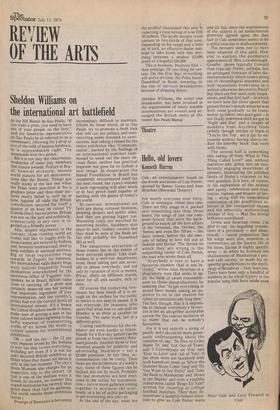RE VIEW
OF THE ARTS
Sheldon Williams on the international art battlefield
At the XII Bienal de Sao Paulo, "If You want a prize, you need to have one of your people on the Jury,” said the American representative (in Sao Paulo he is referred to as a. commissar). Allowing for a drop or two of the milk of human kindness, he is approximately right. The Americans won two prizes. But it is not only the chauvinistic tendencies of some jury members that ensure awards. Politics in Bra zil, however eccentric, assume world stature for art demonstra tions like the Bienal. Things got really sticky at the last one when the Poles were pencilled in for a graphics prize and then their pic tures nearly failed to turn up in time. Against all odds, the British contribution secured for itself a quarter of an hour on colour TV (Canela Dos!), but no prizes. Britain was not on the jury and politically, commercially at any rate, is regarded as a friendly power. Also, despite arguments to the contrary, those running world art events still like to juggle with fa mous names, are swayed by fashion and, however international, tend to keep exhibits in national sections. Big or local reputations reap rewards. In Zagreb, for instance, the international ndifs drawn from sixty nations frequently found themselves overwhelmed by the enormous influx of Yugoslav con tenders. As in Brazil, Britain came close to carrying off a prize and certainly deserved one but lacked that important ingredient of jury representation, and the country's artists had not the correct quota of international esteem. It's a lesson the United Kingdom needs to learn; make sure of getting a seat in the inner cabinet before agreeing to the hefty expense of transporting
works of art across the world to culture centres for international exhibitions.
Oh — and tax too — the 12 per cent impost° levied by the Italians (a new tax that covers everything, including art even if it is not for sale) daunted British exhibitors at
Milan when they found out about it only at the last moment. The city's Brera Museum also charges for an inspection trip to the airport. (If that is one of the mafiosa ways it boosts its income, no wonder this august institution has recently shut down more than half its galleries. The world resents these ambitious extras.)
Prestige of Biennales is becoming increasingly difficult to maintain. Efforts by those which, as at Sao Paulo, try to promote a fresh look that will cut out politics and manoeuvring seem doomed to semisuccess. Just taking a theme for the entire exhibition like "Communication", backed by the findings of an international seminar summoned to weed out the more obvious flaws, neither has practical response nor goes far to furbish a new image. In desperation the Bienal Foundation in Brazil has completely reconstituted itself for the next round, but cynics wonder if such regrouping will alter much or in fact prove itself capable of battling with the giants of today's art world.
In contrast, international art fairs are doing colossal business, pleasing dealers and public alike. And they are getting bigger too. Mounting costs are matched by mounting profits. Snobbery also plays its part. Gallery owners feel they must be seen at the Basle art fair and probably the Dusseldorf IKI as well.
The ubiquitous attraction of these events lies in the extent of their universal appeal. Like stallholders in a well-run department store, those taking part aim severally to please everybody, and not only by variation of style or metier. Prices, albeit on different stands, cater for all and sundry, rich or poor.
Of course the jockeying continues, but how much of it is enough on the surface for the public to notice is not easy to assess. It is not everyone, for instance, who spots that what was on one stall on Monday is on show at another on Tuesday. The same work, but at a different price.
Costing ramifications for the exhibitor are even harder to follow. Stands for a five-day period can be priced at from two to twenty thousand pounds. Another three or four hundred pounds for publicity and advertising. Insurance — say a £2,000 premium. At fair time, ac commodation can be costly. Then there are the incidentals of a week's stay. Some of these figures can be faulted, but not by much. Probably the real economies are best exer cised in the outlay for transportation — two or more galleries joining together to minimise the overheads, or a bit of skilful packaging to get everything into one car. At the end of the day, what are is the profits? Dusseldorf this year Is expecting a total billing of over DM 30 million. The profit margin could amount to two-thirds of that sum. Depending on his range and a little bit of luck, an effective dealer may hope to take home with him anything between a modest £2,000 pront or a hopeful E50,000.
This is business. Business first — then prestige. Of one thing be certain. On the first day, everything will arrive on time. No Poles haunt Dusseldorf or. Basle, teetering on the rim of nervous breakdowns because of.shipping delays.. • Sheldon Williams, the writer and broadcaster, has been involved in the organisation of many notable international art events and arranged the British entry at the recent Sao Paulo Bienal


































 Previous page
Previous page